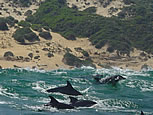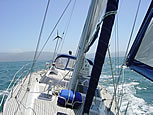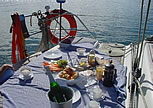![]()
A WHALE IN OUR WAKE

Vacationtechnician personalized luxury adventure travel transports you to the most exquisite wilderness and chill out retreats on Earth. Conserving rare biodiversity through low volume tourism; our aim is your indulgence -at no one's expense. Plan now to be assured a rejuvenating escape at a restful pace -to an unspoilt gem in the purest sense.
Out at sea, swaying with the rhythm of the swell, we are acutely aware that the massive creature rising next to the boat is eyeing us curiously. 'It's a southern right whale,' identifies local guide Simphiwe Ngwetzina, as he reaches for his logbook to record the sighting. Several of us have seen whales spyhopping ('standing' vertically with their heads above the water) from lookouts on land, but there is something magical about being approached and being made to feel the object of observation rather than the observer.
Until two years ago, Ngwetzina had never set foot on a boat. Singled out from the workers at the Komicx fish factory in Kommetjie because of his sociable nature, he has not only grown to love the whales, but has also amassed a wealth of information about them from the various courses he has attended. As we stand on the boat, listening to the compressor blow of the whale and watching as she gently flips her flukes above the water before diving to get closer still, it is easy to understand why he prefers this job to his work at the fish factory.
All too soon our 20 minutes are up and, in accordance with the whale-watching regulations, our skipper ends the encounter and we motor away, to be treated to the sight of a school of common dolphins, their sharp fins ploughing through the water some distance away. We don't approach the dolphins as they are on the hunt. The crew is clearly ecologically aware - and honest enough to admit that this is a commercial venture to generate funds that will assist the Ocean View and Masiphumelele communities, stake-holders in the Simon's Town boat-based whale-watching (bbww) venture.
Some 13 to 20 bbww permits are issued annually for the entire South African coast by Marine and Coastal Management (MCM), based in Cape Town. The 20 areas around the coast that they cover are interspersed with boat-exclusion zones such as the De Hoop Nature Reserve, an important calving ground for southern right whales. MCM began issuing the permits in 1998, largely in response to pressure from local entrepreneurs and in order to avoid the problems posed by a growing uncontrolled industry. Its approach has been precautionary and based on several years' research, as well as on consultations with NGOs, local communities and other interested parties. The progress so far seems promising, although from some quarters come accusations of mismanagement, due to insufficient capacity. It is, for example, disappointing that, at the time of writing this article, MCM had failed to issue some permits for the east coast in time for the peak in the northward migration of humpback whales. On the east coast, humpback whales are more commonly sighted than southern right whales, and make for superb viewing because of the frequency and enthusiasm of their water acrobatics.
Although whale- and dolphin- spotting from boats is currently a fledgling industry in South Africa, it is already big business elsewhere in the world. In a recent report published by the International Fund for Animal Welfare, author Erich Hoyt estimates that whale-watching worldwide has boomed into a billion-dollar industry and makes important educational, environmental, socio-economic and scientific contributions. Since the last global survey in 1994, some 22 countries have started whale-watching tours, and Africa is cited as currently witnessing the fastest growth in whale-watching of any continent.
The expanding interest in whale-watching in South Africa is, in the main, attributable to the initiatives and support of the MTN Whale Route. However, whale-watching from boats still plays only a minor role, perhaps because of superb land-based whale-watching alternatives, coupled with fares geared more towards the overseas visitor than the local enthusiast. But it is bound to boom once news spreads of the unrivalled range of offshore opportunities in a country bounded by two oceans of contrasting character. Our seas host one of the greatest diversities of whales and dolphins anywhere in the world, with at least 38 species of cetaceans having been recorded. This is almost half the total number known to science and includes one species, Heaviside's dolphin, which occurs nowhere else.
Sail from a slipway at Saldanha Bay on the west coast and you are likely to encounter not only southern right whales and dusky dolphins, but also the compact little Heaviside's dolphin, which lives in the cold waters of the Benguela Current from Cape Point northwards to the Kunene River. Intermingled with the familiar west coast smell of salt spray, mist and bokkoms (dried fish) is the less appealing rankness of guano, but if you're determined and venture close to a west coast island such as Malgas, you'll be more than rewarded by the sight of hundreds, or even thousands, of gannets flaunting their aerial skills. Or perhaps a Bryde's whale will exhale close enough to your boat for you to hear the soft sigh of its blow.
From the west coast down to Cape Town and the Overberg area and then eastwards to the Garden Route and beyond, to the warmer waters off the Eastern Cape and KwaZulu-Natal, boat-based trips are sold as a broader ecotourism experience that includes seals, penguins, seabirds, sharks and dolphins in addition to the whales. Part of the excitement of whale- and dolphin-spotting lies in the uncertainty of what you'll see next. In January this year, scientists from the MTN Centre for Dolphin Studies (CDS) in Plettenberg Bay saw Heaviside's dolphins, the first confirmed sighting east of Cape Point. The month before, they had glimpsed a rare beaked whale species that they are still unable to identify conclusively. CDS, an official bbww permit-holder, has introduced a unique link between non-profit research and commercial whale-watching through their commercial subsidiary Spyhopper Adventures. This operation offers whale-watchers an opportunity to learn from the experts, and at the same time provides a valuable platform and support for the scientists' research.
Perhaps the biggest boom currently taking place is that experienced by operations along the Garden Route, off the southern Cape coast, some of which are strongly linked to community projects. No doubt the success of these ventures is at least partly attributable to the high probability of seeing orcas (or killer whales) as well as species such as southern right, humpback and Bryde's whales, in addition to common, bottlenose and humpbacked dolphins. Although there is currently an uneven distribution of interest around the country, some 15 000 local and international enthusiasts ventured out to sea last year. It seems that whale- and dolphin-watching in South Africa is set to start rivalling the rush to see the Big Five of the game parks.
Whale-watching is clearly a profitable venture for humans, but at what cost to the whales? This varies from place to place, but properly planned and carefully controlled whale-watching can help to encourage vital support for marine conservation and to assist in the gathering of scientific information. The MTN Whale Route is playing a vital role not only in establishing and supporting whale-watching initiatives, but also in acting as watch dogs of the industry. South Africa is fortunate in that, as a latecomer, it has had the opportunity to learn from the mistakes made by other countries and to take the necessary precautionary measures to ensure that maximum benefits accrue to all, including - or especially - the whales.
Heavy boat traffic has been shown to have negative effects on whale populations elsewhere in the world. It is not known to what extent the energy these animals need to breed is compromised if they change their behaviour when disturbed and, for example, spend more time underwater and increase their metabolic rate. Nor is it known what the effect of boat disturbances may be on the mother-calf bond. This is very strong in cetaceans, and a female with a young calf may protect her offspring aggressively if she feels it is threatened. In South Africa, boat-based operators are not permitted to approach cow-calf pairs.
Research into the precise impact of boat noise on whales is inconclusive at present, but the impact is surely not negligible if one considers the complexity of cetacean sensory and communication systems. It has been suggested that the cumulative impact of general boat traffic around whales disturbs them more than does outright harassment by single boats. In some areas, on the other hand, individual whales have gradually adjusted to the presence of the boats and actively initiate and solicit contact with the vessels and their human occupants, and even enjoy being touched. (Cetacean skin, despite its thick blubbery appearance, is surprisingly sensitive to touch because of the presence of specialised nerve endings which play a role in reinforcing social contacts and in locomotion.)
South Africa's strict whale-watching regulations are aimed not only at minimising harmful impacts on cetacean populations, but also at ensuring the sustainability of whale-watching operations. Based on extensive research and observations, they include stipulations that vessels should approach a whale from a direction parallel and slightly to the rear, as the animal appears to feel threatened by a head-on approach. Sudden or repeated changes in speed or direction must be avoided, and a whale should not be boxed in, cut off its path or prevented from moving away. Vessels are required to approach at near idling speed to within a minimum distance of 300 metres and are not permitted to approach closer than 50 metres to any whale, leaving it to choose whether or not to move closer.
The high diversity of whales and dolphins around South Africa's coast is a valuable natural resource. By encouraging interest and promoting an awareness of all cetaceans, whale-watchers have a central role to play in their conservation around the world, and in South Africa there is considerable scope for furthering whale-watching initiatives. With several boatloads of schoolchildren scheduled for trips over the coming season, the company Ngwetzina works for, Ocean View and Masiphumelele Fishing, is making a positive contribution to education. In return, the whales afford an opportunity to provide a much-needed economic boost to small communities such as theirs.
Whales only!
In a controversial but progressive move, the Minister of Environmental Affairs
and Tourism in South Africa has announced his intention to declare an area
offshore of the Cape's southern coastline a whale sanctuary. The proposed
area extends from Hermanus to Gansbaai and, with the exception of legally
permitted boat-based whale-watching vessels, will be closed to all other boat
traffic from July to mid-December each year.
The main aim of the sanctuary is to reduce the boat-based disturbances affecting high densities of southern right whales that breed in this region. Although populations of this species are currently increasing at about seven per cent per year, their numbers are still only a small fraction of pre-hunting population estimates and, along with humpback whales, they are listed as an endangered species. The sanctuary proposal is currently being scrutinised, taking into account opposition from fishers, powerboat users, and abalone and seaweed harvesters.
SCIENTIFIC NAMES OF WHALE AND DOLPHIN SPECIES MENTIONED IN THE TEXT
Southern right whale Eubalaena australis
Humpback whale Megaptera novaeangliae
Bryde's whale Balaenoptera edeni
Orca (killer whale) Orcinus orca
Short-beaked common dolphin Delphinus delphis
Long-beaked common dolphin Delphinus capensis
Dusky dolphin Lagenorhynchus obscurus
Heaviside's dolphin Cephalorhynchus heavisidii
Bottlenose dolphin Tursiops truncatus
Indo-Pacific humpbacked dolphin Sousa chinensis
Nature Reading
Cheetahs
Born to be Wild
Leatherbacks and Loggerheads
Giraffes in Africa
Rhinos in Africa
African Trees
River Horses:
Hippopotamus
Marine Marvels of Maputaland
Survival Strategies
of African Butterflies
Whale and Dolphin Watching
Great
White Sharks near Capetown, South Africa
Run Sardine Run!
---------------------------------------------------
Listening • Understanding •Planning
Introduce Yourself -
Scheduled Trips - Private Safaris
- Newsletter
About Us - Our Mission
- Our Philosophy - Yacht
Charter - DryGoods
![]() We speak English
We speak English
![]() Wir sprechen Deutsch
Wir sprechen Deutsch
![]() On parle français
On parle français
![]() Parliamo italiano
Parliamo italiano
info at vacationtechnician dot com
Thanks for visiting vacationtechnician.com
Friendly•Dependable•Knowledgeable•Experienced
© 1998-2007 vacationtechnician.com All Rights Reserved




